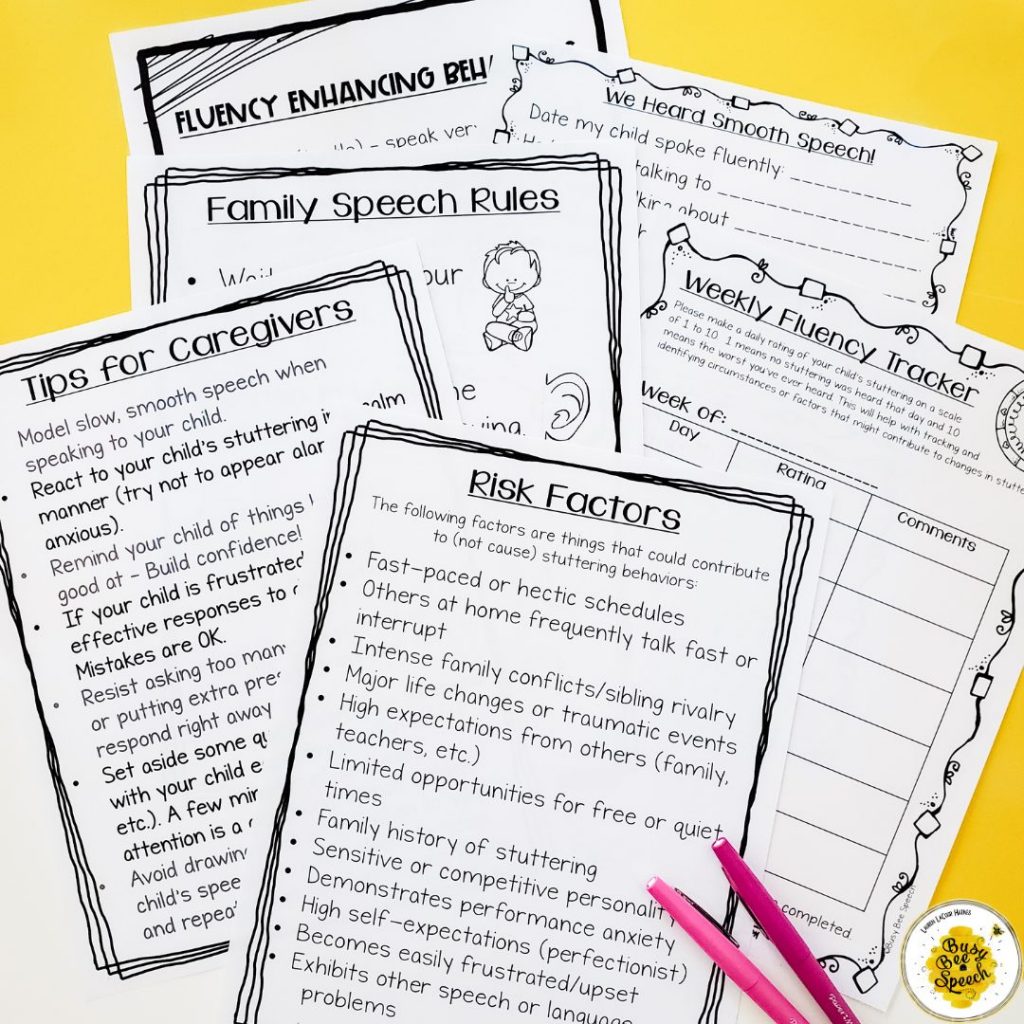Let’s talk about stuttering in preschoolers for a second. I do consider fluency therapy to be a little different in preschool kids compared to school-aged kids. This is mostly due to their young age and ability levels, but it’s also because with preschoolers there’s more emphasis on the parent education component.

Plus, a lot of times your little bitty friends can’t really tolerate sitting and completing a lot of education tasks and strategy practice. Here are a few tips I’ve found helpful when working on stuttering in preschoolers.
1. Keep a routine
I try to keep somewhat of the same routines and structures with any of my preschool kids, so that goes for my fluency friends too. This helps the student to know what’s coming next, so if we have to do a task that may take some sitting, they know it won’t last long. Schedules also help me be more intentional in my planning. Having a visual schedule handy is definitely a must for me as well.
An example fluency therapy routine might go something like this:
- Cut and paste activity from binder: Teach students about bumpy and smooth speech
- Structured play: Have students earn Legos or blocks by telling me if my speech was bumpy or smooth.
- Read a book together: Read Goldilocks and the 3 Bears and talk about “too much/too little/somewhere in the middle.” Talk about how it relates to our speech (not too fast or too slow, not too tight or too loose).
- Free play: I model a timing strategy and have the student repeat and practice with me.
2. Play
Speaking of play, I’ve found that incorporating play therapy with preschoolers is super effective. However, you want to be strategic about setting up your play and what you’ll be doing during that time. Just playing and winging it (which, heck, we’ve all done) is ok, but planned play is so much better.

I like to incorporate 2 types of play.
- Structured play: A game or activity with toys that has a goal or ending point. Examples would be building a 10 block tower, making a house with legos, bean bag toss, hopscotch, games like red light/green light.
- Free play: Open-ended play with toys. Examples include dolls, animals, Little People houses, cars, dramatic play, etc.
When playing you want to be either educating the student or doing strategy modeling/imitation with the student. I like using structured play for education and modeling/imitation for free play.
3. Get parents involved
Parent education is a pretty important component to stuttering therapy with preschoolers. When working with parents and family, you want to teach them how to modify their environment and communication techniques. I tell them about the risk factors for stuttering and tips for the home environment.
It’s helpful to send parent letters, handouts, and daily fluency trackers home to help them implement those changes. I even made a “rules” poster for parents as well as teachers to just help with good basic communication skills because it’s not always as common sense to everyone that it is to us.

Essentially we want parents to learn to slow their rate when speaking around the child and then to reduce the verbal demands that they place on them. We also want to teach parents how to respond appropriately when their child does stutter. We want them to respond in a calm manner and model effective responses to difficulties in general. It’s OK to make mistakes – in life and in speaking.

When the child is ready, you can also teach parents the verbal contingencies, both for stutter-free speech and for stuttering, based on the Lidcombe Program. If you don’t know what those are, basically in stutter free speech, a parent can respond by praising their speech (“That was good talking.” Or “That was really smooth.”) or can ask the child to evaluate themselves (“Was that smooth?”).
After a moment of stuttering, a parent can respond by acknowledging it (“That was a little bumpy.”) or by having the child correct it (“Can you try saying that again?”). The Lidcombe Program is a good research-based technique for preschoolers and definitely worth exploring further if you haven’t looked into it.
4. Resources
Here are some of my go-to resources that have made my SLP life a LOT easier.
- Preschool Fluency Binder – This is filled with everything you need to start fluency therapy. It comes with parent education handouts, trackers, and age-appropriate student cut/paste activities for education, counseling, and strategy practice.
- Book by Stuttering Therapy Resources – This practical guide is very thorough and includes research and amazing ideas for therapists to have a well-rounded picture of fluency therapy in preschoolers.

- Parent Handouts – Grab some great free parent handouts from my resource library by joining the BBS email community! I’ve got some more general handouts, as well as these supporting fluency through play tips!
I hope some of these ideas helped you! Follow me on Instagram to stay updated on lots more ideas and tips for stuttering in preschoolers. 🙂












Leave a Reply